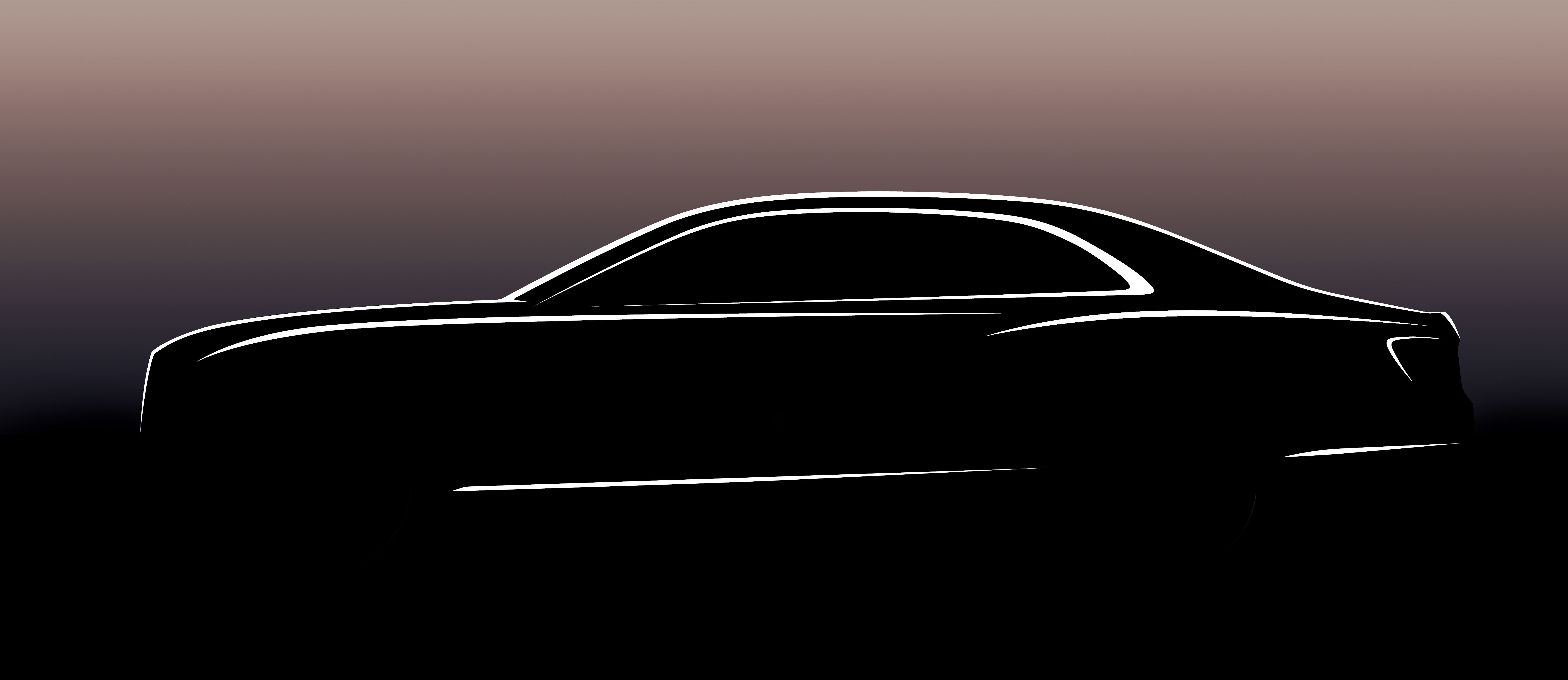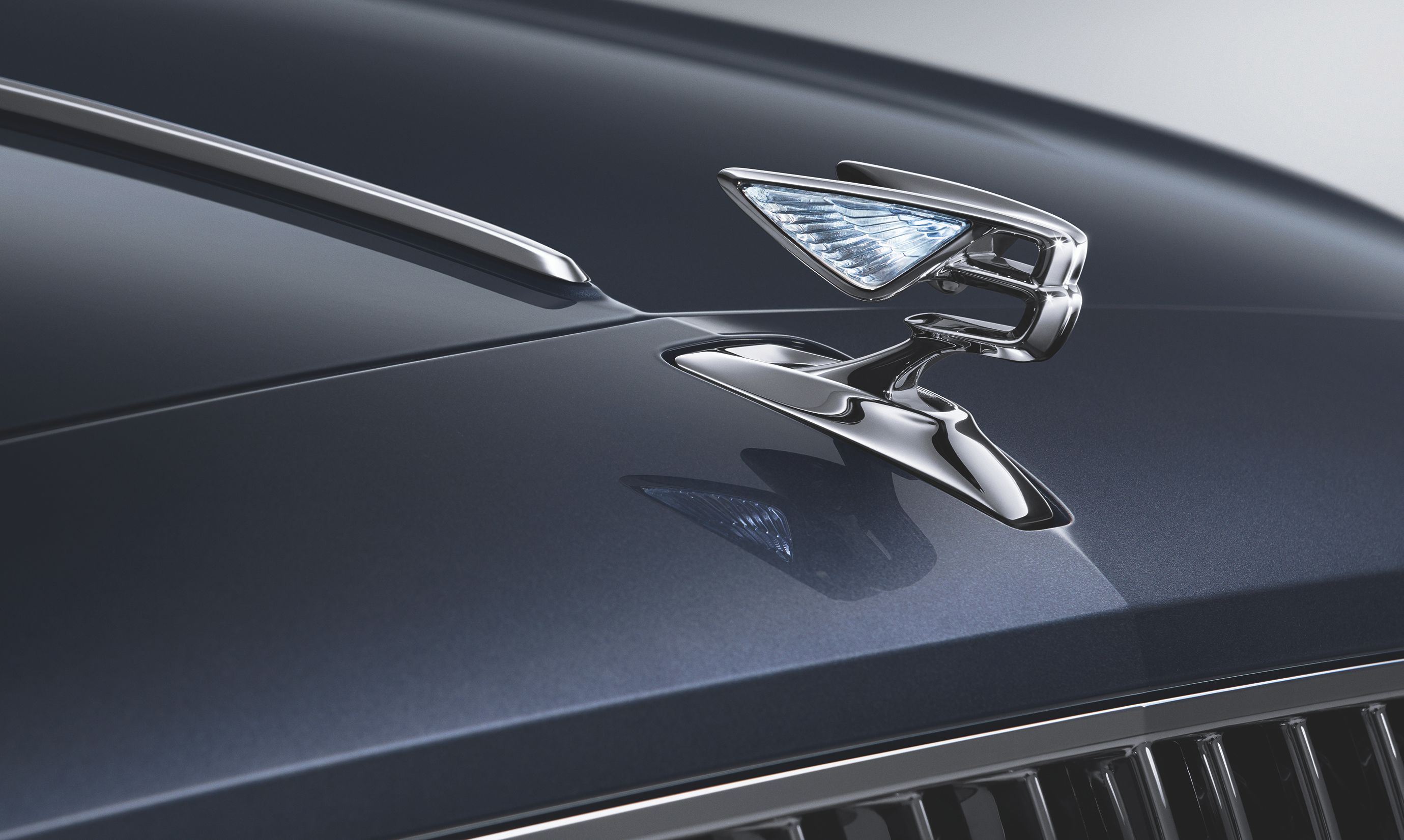Two years on from the unveiling of the third-generation Continental GT, Bentley is doing the groundwork before presenting to the world its majestically brutal Continental GT with two bonus doors, otherwise known as the Flying Spur. So far, the British manufacturer has only released a vague teaser image showing the car's silhouette, and now we're seeing its retractable hood ornament in detail. Will the Rolls-Royce Ghost be schooled by the new Bentley?
Bentley and Rolls-Royce used to be two birds of a feather merely a couple of decades ago but, since they ended up under different ownership in the early '00s, Britain's two top luxury brands have arguably taken two different routes. Bentley, soaking in all of its sporting credentials and a rich motorsport heritage, specialized in brisk sedans and sumptuous grand tourers while Rolls-Royce decided to stay true to its own heritage and kept putting out full-size sedans that abounded in lavish materials and state-of-the-art equipment while more recently tapping into the niche of limited-edition models. The two brands are, as such, quite different in their image now but the upcoming Flying Spur will still have to worry about whatever Rolls-Royce is doing with the Ghost because, as you know, a new Ghost is on the way as well.
No more happy round edges for Bentley's luxury sedan either
On the year of its 100th anniversary, Bentley started previewing the third generation Bentley Flying Spur (the second to omit the 'Continental' moniker from its name in a bid from Bentley to move the car a bit away from the Continental GT's performance orientation and keep it as a more relaxed offering in the minds of the clientele). It's one that's been somewhat overdue since the second-generation model has been around for six years already.
Now, let's first talk about what we see. The video is just 31 seconds long, and in it, without any distraction from a musical backdrop of some sort, we see the retracting ornament revealing itself from its hiding place behind the front fascia. What is interesting about the ornament is that it's been redesigned. Now, the opened wings are no more connected fully to the B and the lower part of the angled letter is left open. The wings themselves are illuminated from the inside whereas before the ornament was one single element without any other tricks up its sleeve. The video's description is boastful, to say the least with Bentley claiming that it's innovating "beyond the existing boundaries of performance, refinement. and luxury." While Rolls-Royce will surely have something to say about that, it means anyway that the new 'four-door grand tourer' aims to raise the bar much further than its predecessor did.
With the video done and dusted, we can move on to the land of hopes and dreams otherwise known as the part where we discuss what the new Flying Spur should offer to not find itself lagging behind whatever Roller will have to offer in the new Ghost. For starters, let's talk about visuals. The previous two Flying Spurs (the second designed by Luc Donckerwolke) were both rather round cars complete with circular headlights and taillights with rounded out corners. The third-generation model retains the roundness in the front and rear light clusters, but it gains the much more muscular and broader appearance of the current Continental that is, undoubtedly, a more boxy car. Happily, we don't have to use our imagination too much to envision how the new Flying Spur will look like, because it was caught rolling around and about virtually without any sort of camouflage.
We showed you a render of the 2020 Flying Spur almost a year ago when we heard that the Flying Spur will become, along with its Continental GT brethren, the final non-electrified Bentley and also the last to sport this design language (although the language itself is as new as the latest Continental GT so that may not be true). >
If the two-door model features two separated air vents on either side of the lower one in the middle (which is where the fog lamps are located), on the Flying Spur the main lower grille goes down and below the two side grilles that are separated merely by a reversed L-shaped bar. This is about the only detail that sets the two models apart as the quad headlights (with the outboard ones smaller in size) are the same. That and the name. If you're a history buff, you probably know already that, according to Bentley, the car "owes its name to coachbuilders H.J. Mulliner, whose inspired idea to offer a four-door body on the Continental chassis created the Continental Flying Spur in 1957."
This change in style for the Flying Spur will bring somewhat closer to the Ghost, but the Bentley still has a lower-slung look to it with a lower hood and trunk line, with the same swooping line in the back set to remain. While we haven't seen the new Ghost exposed, by the look of the highly camouflaged mules, I reckon Rolls-Royce will continue to offer a bricky sedan as its sub-Phantom offering.
The Flying Spur V-8, introduced in 2015, delivers 500 horsepower at 6,000 rpm and 488 pound-feet of torque at just 1,750 rpm from an Audi-derived 4.0-liter, turbocharged V-8. Both engines received a new ECU over the first-generation Flying Spur and, in my reckoning, something along these lines will happen again as the emission laws are getting tougher by the day and efficiency is the name of the game.
Bentley Flying Spur W12
Bentley Flying Spur V-8
Bentley Flying Spur V-8 S
Engine
6.0-liter twin-turbocharged W12
4.0-liter twin-turbocharged V8
4.0-liter twin-turbocharged V8
Capacity
5,998 cc
3,993 cc
3,993 cc
Horsepower
616 HP @ 6,000 RPM
500 HP @ 6,000 RPM
521 HP @ 6,000 RPM
Torque
590 LB-FT @ 2,000 RPM
487 LB-FT @ 1,700 RPM
502 LB-FT @ 1,700 RPM
0 to 60 mph
4.3 seconds
4.9 seconds
4.6 seconds
0 to 100 mph
9.5 seconds
11.2 seconds
10.6 seconds
Top Speed
199 mph
183 mph
190 mph
The main difference between the first Flying Spur, named Continental Flying Spur, and the second one was the philosophy behind them. As I mentioned before, Bentley realized that its core market does not really want a four-door Continental GT that they can drive themselves. Instead, they wish for a more serene luxury sedan in which they can be chauffeured in, albeit one that looks less blocky than a Rolls-Royce. You may think otherwise, but the fact of the matter is that over half of the people that buy Flying Spurs come from China and Chinese customers like their cars nice and soft. The second-gen Flying Spur features 25% softer bushing and also softer spring rates and anti-roll bars by 10 to 15%.
Expect the trend to continue with the new model as a Bentley that's too stiff will just divert customers towards the nearest Rolls-Royce dealership that's known for not caring about stiffness or any semblance of sporty nature - although you can't call a Ghost sluggish with its 562 horsepower and 575 torques via a 6.6-liter, twin-turbocharged V-12. The big thing Bentley is probably keeping in mind right now, though, is not engine-related nor is it gearbox-related (Rolls-Royce also employs a six-speed unit) but it's got to do with the chassis. That's because the new Ghost is finally getting a bespoke aluminum chassis and moves away from the steel monocoque shared with the BMW 7 Series. With aluminum being lighter, the whole car will be lighter and also stiffer all at once. According to Autocar, the new Ghost is getting a "6.6-liter, twin-turbocharged V-12 developed to Rolls-Royce’s own specifications by BMW. That engine develops 577 horsepower and 626 pound-feet of torque in the range-topping BMW M760Li xDrive, but sources suggest it could produce more in the new Rolls-Royce."
Meanwhile, inside the VAG Group, there is some potential sharing scheme in the making too. This leads me to the all-important cabin. It really doesn't matter how much oomph the engine makes, how stiff the chassis is or how small the panel gaps are (or how clever the hood ornament is) if the interior doesn't match the ultra-luxurious aspirations of both of these legendary brands. Both of them will want to make a statement with the new models without shocking their client base. That's why I wouldn't expect broad changes in the cabin of the new Flying Spur - also because they aren't needed. Autocar reported that the only thing the old Flying Spur would've used more of was front headroom and we won't know if this issue has been addressed in the new model. Viewing the issue from a different angle, as long as you never drive the car yourself and you're just driven around, you don't really care about this aspect - it's the chauffeur's job to fit inside, hat included or not.
There will be, too, a touch of novelty thanks to the two digital screens, one behind the wheel for the gauge cluster and one in the middle that will act as the HQ of the infotainment system. Be sure Bentley's new (and amazing) rotating display system, a collection of 12.3-inch digital screens housed in a three-sided unit that revolves in the center console. They will complement other high-tech safety features (everything from lane assist, traffic warning, 360-degree cameras to some sort of autonomous driving systems plus Apple CarPlay, real-time traffic, and Private eCall for emergency services) and stuff like LED taillights and, maybe, laser headlights - the Ghost will get'em so Bentley can't lag behind.
This engine, that's also utilized by Porsche in the Panamera Hybrid, is aided by an electric motor that pulls double-duty as a generator. The electric motor generates 134 horses and 295 pound-feet of torque for a total output of 456 horsepower and 516 pound-feet. This is somewhat comparable (with a little bonus in the torque department) with the current Flying Spur V-8.
In the Bentayga, the electric motor can go on its own for 31 miles, and it needs 7.5 hours to recharge via a domestic socket and under three hours if connected to a more powerful source like those in the EV charging stations. With the Flying Spur underpinned by the same MSB-F platform as the Panamera, I'd expect them to share the engine and other bits so those figures could stand. With this being said, Porsche offers the S-E Hybrid model that combines a turbocharged V-8 with the electric motor for a combined output of 671 horsepower and 627 pound-feet. I don't think Bentley will aim for such insane figures though.
Engine
3.0-liter V-6 gasoline mill and an E Motor
Horsepower
456 HP
Torque
516 LB-FT
0 to 60 mph
5.2 seconds
Top Speed
158 mph
Range (electric only)
31 miles
The Hybrid will probably be priced in between the V-8 and the W-12. Expect the V-8 to tip just above $200,000 while the W-12 will have an MSRP of over $250,000 but this will still probably be less than a Ghost since the MSRP for a 2019 Ghost is $311,900 versus just $244,600 for a 2018 model year Flying Spur W-12 S. Granted, if you have this amount of money and you're ready to dispose of it in exchange for a car, $40,000 won't be a deal-breaker for you. It's all about what suits your needs, your style, and what kind of image you want to display to the outside world.
Read our full review on the 2020 Bentley Flying Spur
Read our full review on the 2020 Bentley Flying Spur Hybrid
Read our full review on the 2017 Bentley Flying Spur V8 S.
Read our full review on the 2017 Bentley Flying Spur W12 S.
Bentley Bentayga Hybrid drivetrain specifications
Further reading


